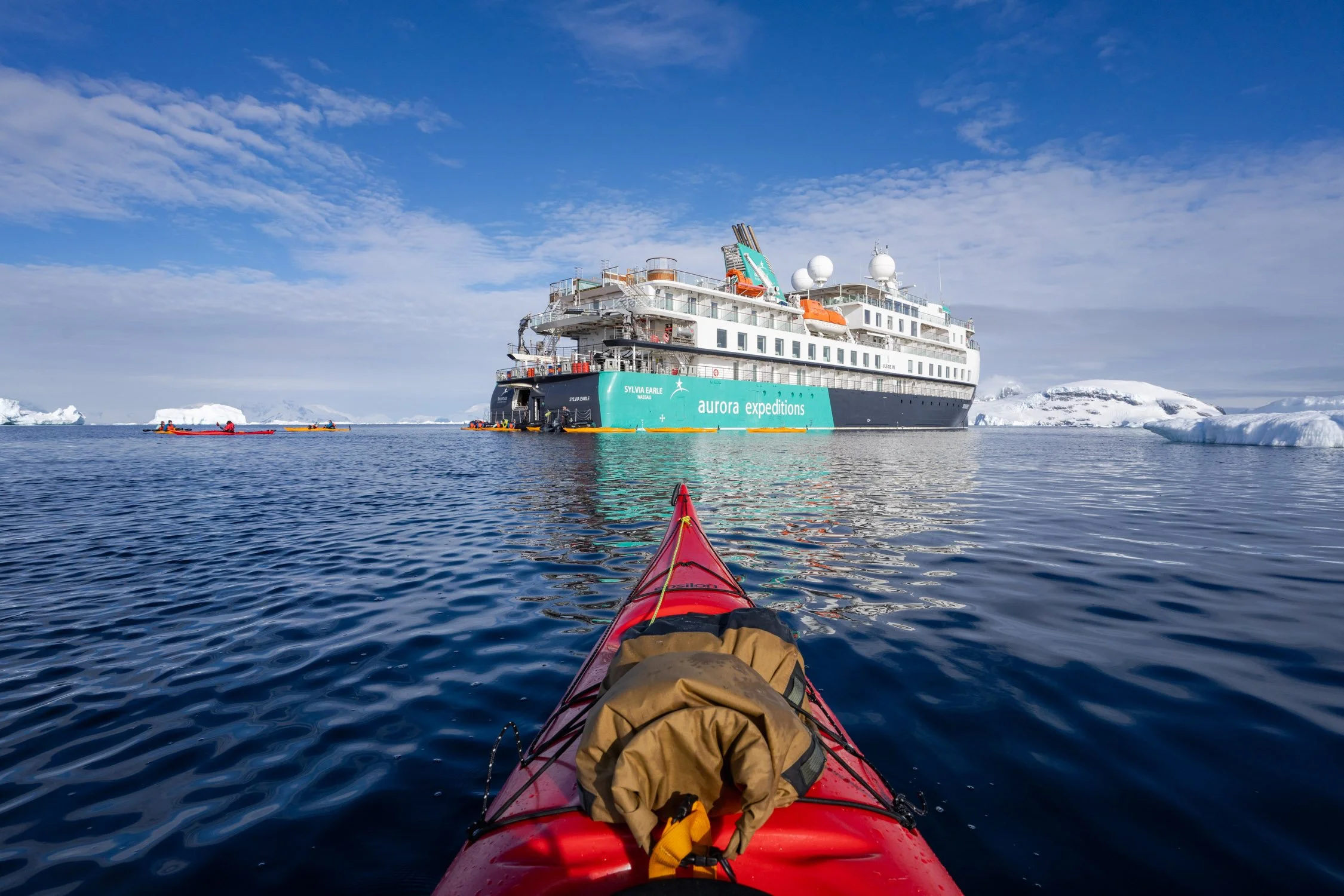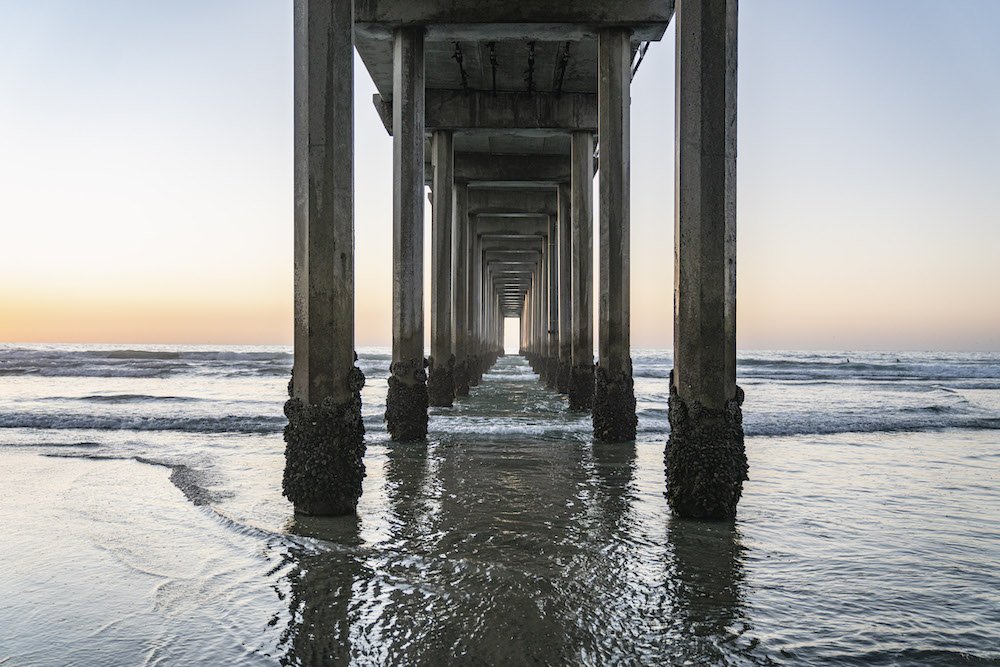Here's How You Pick The Right Antarctica Cruise
Antarctic cruises typically last between 10 to 24 days. The duration of your cruise depends on several factors, including the specific itinerary, the cruise line, the departure port, and the type of activities you wish to engage in. Understanding these factors can help you choose the Antarctic adventure that best suits your interests and schedule.
Kayaking back to the ship after paddling around icebergs along the Antarctica Peninsula. Photo by Dalton Johnson
Itinerary and Duration
The length of your Antarctic cruise is primarily determined by the itinerary you select. Standard itineraries that focus solely on the Antarctic Peninsula generally last between 10 to 15 days. These cruises offer a comprehensive experience of the region's stunning landscapes and unique wildlife without requiring an extended time commitment. During these trips, you'll have the opportunity to visit iconic spots such as Paradise Bay, Deception Island, and the Lemaire Channel.
Longer itineraries, which can last up to 24 days or more, often include visits to additional destinations such as the Falkland Islands and South Georgia. These regions are rich in history and wildlife, offering a more in-depth exploration of the Southern Ocean's ecosystems. In South Georgia, for example, you can witness massive King Penguin colonies and explore historic whaling stations, while the Falkland Islands provide opportunities to see a variety of bird species, including the black-browed albatross.
Departure Ports
The departure port also affects the length of Antarctic cruises. The most common starting point for Antarctic cruises is Ushuaia, Argentina. Ushuaia, known as the "Gateway to Antarctica," is the southernmost city in the world. Cruises departing from Ushuaia typically range from 10 to 15 days for standard itineraries. The proximity of Ushuaia to the Antarctic Peninsula minimizes travel time across the often turbulent Drake Passage.
Other departure ports, such as Punta Arenas in Chile or even more distant locations like Buenos Aires, Argentina, or ports in New Zealand and Australia, can add to the cruise duration due to increased travel distances. These cruises may include additional days at sea or stops at other sub-Antarctic islands.
Big Cruise vs. Small Cruise
The type of vessel you choose can significantly influence your Antarctic experience. Large cruise ships and small expedition vessels each offer distinct advantages and cater to different types of travelers.
Large Cruise Ships:
Capacity: Large ships can accommodate several hundred passengers, offering a wider range of amenities such as multiple dining options, entertainment venues, and more extensive onboard facilities.
Stability: Larger vessels tend to be more stable in rough seas, providing a smoother ride across the Drake Passage.
Activities: While large ships may offer fewer opportunities for shore landings due to strict environmental regulations, they often provide a variety of onboard activities and excursions such as scenic cruising, whale watching, and educational lectures.
Small Expedition Vessels:
Capacity: These vessels typically carry fewer than 200 passengers, allowing for a more intimate and personalized experience.
Flexibility: Smaller ships can navigate narrower channels and reach more remote locations, offering more frequent and varied shore landings and zodiac excursions.
Activities: Expedition vessels focus on immersive experiences, including activities such as kayaking, camping, and guided hikes. The smaller group sizes enhance wildlife encounters and provide greater access to expert guides and naturalists.
Related Read: SMALL SHIP VS BIG SHIP CRUISE: DISCOVER YOUR IDEAL CRUISE EXPERIENCE
Wildlife Watching vs. Adventure Activities
Your interests and preferred activities will also influence the duration and type of Antarctic cruise you choose.
Wildlife Watching:
Focus: Cruises focused on wildlife watching emphasize observing and photographing the diverse species that inhabit the Antarctic region, including penguins, seals, whales, and seabirds.
Itineraries: These cruises often include extended time at key wildlife hotspots, such as penguin colonies and seal haul-outs, and may feature expert-led lectures and presentations on Antarctic wildlife.
Duration: Wildlife-focused cruises can range from shorter trips (10-15 days) to longer expeditions (up to 24 days) that include visits to the Falkland Islands and South Georgia, offering a more comprehensive wildlife experience.
Adventure Activities:
Focus: Adventure-oriented cruises offer a range of activities designed to immerse travelers in the Antarctic environment, including kayaking, camping, snowshoeing, and even scuba diving.
Itineraries: These cruises prioritize destinations that offer the best opportunities for outdoor activities and may include extended time in locations known for their dramatic landscapes and adventure potential.
Duration: Depending on the range of activities and destinations included, adventure cruises can also span 10 to 24 days. Longer itineraries may provide more opportunities to engage in multiple activities and explore diverse regions.
Additional Travel Time
When planning your Antarctic cruise, it's essential to factor in additional travel time beyond the cruise duration itself. Travelers should add at least two days of travel to and from their departure point. For most, this means accounting for international flights to South America, typically arriving in Buenos Aires or Santiago, and then taking a connecting flight to Ushuaia or Punta Arenas.
Moreover, it is highly recommended to arrive at your departure city at least one day before your cruise sets sail. This buffer day allows for any unexpected travel delays, such as flight cancellations or missed connections, ensuring you do not miss your cruise departure. This extra day can also be a great opportunity to explore your departure city. In Ushuaia, you can visit the Tierra del Fuego National Park, take a boat tour on the Beagle Channel, or simply enjoy the local cuisine and culture.
FAQ About Cruising to Antarctica
1. What is the best time of year to cruise to Antarctica?
The best time to cruise to Antarctica is during the austral summer, which runs from late October to early March. This period offers the most favorable weather conditions, with temperatures ranging from -2°C to 8°C (28°F to 46°F). The season is divided into three main parts:
Early Season (Late October to November): This is when the ice begins to break up, and you'll witness the pristine, untouched landscapes of Antarctica. It's also a time to see courtship displays among penguins and the return of seabirds. However, temperatures can be colder, and there's more ice to navigate.
Mid-Season (December to January): This is the warmest time of the year in Antarctica, with longer daylight hours (up to 24 hours of daylight) and abundant wildlife activity. It's the best time for penguin chicks hatching and seal pupping. The ice has retreated significantly, allowing ships to reach more remote areas.
Late Season (February to Early March): This is the peak time for whale watching as they gather in the Southern Ocean to feed. Penguin chicks are growing up, and seals are more active. The ice has melted considerably, making it easier to access various locations.
Related Read: BEST TIME TO VISIT ANTARCTICA ON A CRUISE SHIP
2. What wildlife can I expect to see on an Antarctic cruise?
Antarctica is home to a unique and diverse array of wildlife, adapted to the harsh conditions of the continent. Some of the most iconic species you can expect to see include:
Penguins: The most famous residents, including Emperor, Adelie, Chinstrap, Gentoo, and Macaroni penguins. They are often seen in large colonies, and during the breeding season, you can witness their courtship rituals, nesting, and chick-rearing.
Seals: Several species of seals inhabit Antarctica, including Weddell, Crabeater, Leopard, and Elephant seals. You can observe them lounging on ice floes or beaches, hunting for food, and, in the case of Elephant seals, engaging in dramatic battles for territory.
Whales: The Southern Ocean surrounding Antarctica is a rich feeding ground for whales. Common sightings include Humpback, Minke, and Orca (killer) whales. The best time for whale watching is from February to March when they are most active.
Seabirds: Antarctica and the Southern Ocean are teeming with seabirds, including albatrosses, petrels, skuas, and terns. These birds are often seen soaring above the waves or nesting on rocky cliffs.
3. Do I need any special equipment or clothing for an Antarctic cruise?
Yes, preparing for an Antarctic cruise requires specific clothing and equipment to ensure your comfort and safety in the extreme conditions. Here's a list of essentials:
Clothing:
Base Layers: Moisture-wicking thermal tops and bottoms to keep you dry and warm.
Mid Layers: Insulating fleece or down jackets for added warmth.
Outer Layers: Waterproof and windproof jacket and pants to protect against the elements.
Accessories: Warm hat, gloves, neck gaiter or buff, and thermal socks. Consider bringing glove liners for extra warmth and dexterity.
Footwear:
Waterproof Boots: Sturdy, insulated, and waterproof boots are essential for shore excursions. Many cruise operators provide these, but check beforehand.
Comfortable Shoes: For wearing on the ship.
Other Essentials:
Sunglasses: With UV protection to guard against the intense glare from the ice and snow.
Sunscreen: Even in cold weather, the sun's reflection off the ice can cause sunburn.
Binoculars: For wildlife viewing from the ship.
Camera Gear: To capture the breathtaking landscapes and wildlife. Consider bringing extra batteries and memory cards, as the cold can drain battery life quickly.
Dry Bags: To protect your electronics and other valuables from water and moisture during landings.
4. How physically demanding is an Antarctic cruise?
An Antarctic cruise can be physically demanding, depending on the activities you choose to participate in. Most cruises offer a variety of excursions and activities ranging from leisurely to challenging. Here are some of the common activities and their physical demands:
Zodiac Landings: These inflatable boats take you from the ship to shore. While not overly strenuous, getting in and out of the Zodiacs requires some agility and balance. You may also need to walk on uneven, icy, or rocky terrain once ashore.
Hiking: Many cruises offer guided hikes of varying difficulty levels. Some may be short and easy walks, while others could be more strenuous, involving steep climbs and rough terrain.
Kayaking: This activity allows you to explore the Antarctic waters up close and can be moderately to highly demanding, depending on sea conditions and the duration of the kayaking excursion.
Snowshoeing: Available on some cruises, snowshoeing can be a fantastic way to explore the snowy landscapes but requires a good level of fitness.
Camping: Some expeditions offer overnight camping on the continent, which involves setting up and breaking down camp and dealing with potentially cold and windy conditions.
Overall, a reasonable level of fitness is recommended to fully enjoy the activities offered on an Antarctic cruise. However, most cruise operators provide options suitable for a range of physical abilities.
5. What are the environmental regulations for visiting Antarctica?
Antarctica is a pristine and fragile environment, and there are strict regulations in place to protect its ecosystems. These regulations are enforced by the International Association of Antarctica Tour Operators (IAATO) and other governing bodies. Key regulations include:
Visitor Guidelines: Travelers must adhere to guidelines that minimize environmental impact, such as maintaining a safe distance from wildlife, not disturbing natural features, and not leaving any waste behind.
Biosecurity Measures: To prevent the introduction of non-native species, visitors must thoroughly clean their clothing and equipment before and after shore excursions. This includes vacuuming bags, pockets, and Velcro, and ensuring all footwear is free of soil and seeds.
Wildlife Interactions: Maintaining a respectful distance from wildlife is crucial. This means not approaching or touching animals and allowing them to move freely. Specific distance guidelines are provided for different species.
Protected Areas: Some areas of Antarctica are designated as specially protected areas due to their ecological, scientific, or historical value. Access to these areas is highly restricted and often requires special permits.
Waste Management: All waste must be managed responsibly. This includes carrying out all trash and avoiding any contamination of the environment. Human waste is also handled with strict protocols to prevent pollution.
Zodiac Operations: Zodiac operations are conducted with care to avoid disturbing wildlife and minimizing wake and noise pollution.
Related Read: THE DO'S AND DON'TS OF VISITING ANTARCTICA
Getting close to see a hole in an iceberg while on an Antarctica cruise. Photo by Dalton Johnson
Antarctic cruises typically last between 10 to 24 days, with the duration influenced by the chosen itinerary, cruise line, departure port, and the type of activities you wish to engage in. Adding at least two days of travel time and arriving at your departure city one day early is recommended to ensure a smooth start to your adventure. Whether you opt for a large cruise ship with extensive amenities or a small expedition vessel offering immersive activities, an Antarctic cruise promises a once-in-a-lifetime experience filled with breathtaking landscapes, incredible wildlife encounters, and a deeper understanding of this remote and fascinating region. Proper preparation and planning will help ensure that your journey to the White Continent is as memorable and enjoyable as possible.









